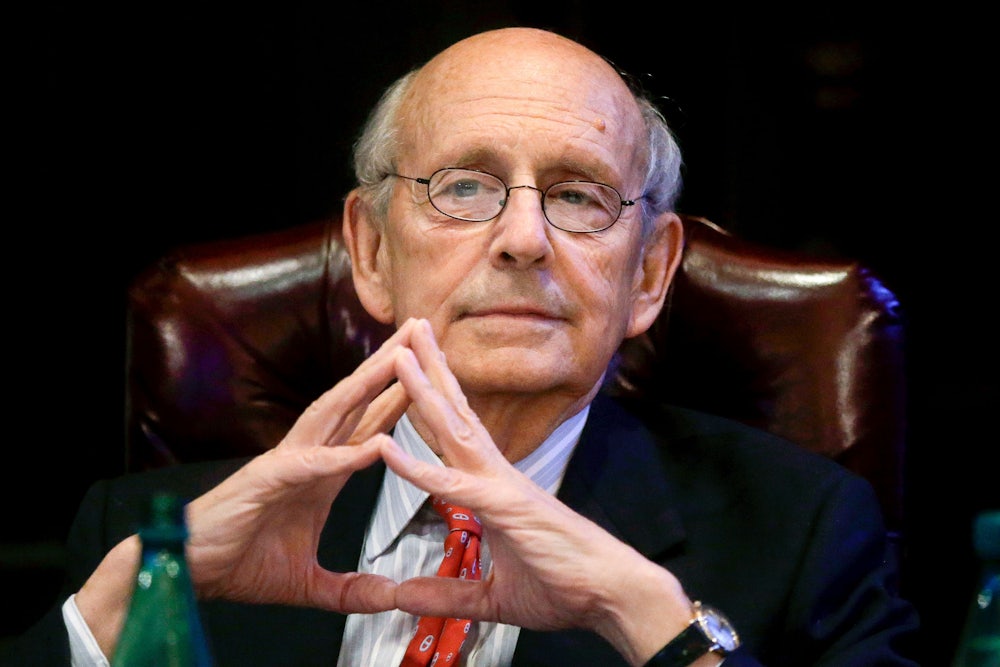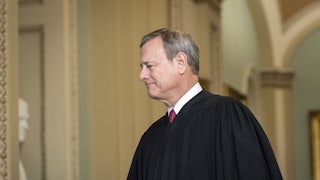Justice Stephen Breyer, the practical and erudite leader of the Supreme Court’s liberal wing, will reportedly retire from the high court at the end of the current term in June. His departure gives President Joe Biden his first and likely only chance to choose a justice, buoying the political fortunes of an administration that has been buffeted by the ongoing pandemic and a floundering legislative agenda.
Breyer’s departure will not significantly alter the court’s ideological balance. With six conservative justices now on the bench, whoever Biden nominates will almost certainly be part of a three-justice liberal minority for the next 15 to 20 years. At the same time, his replacement with a much younger justice will help ensure that the court wouldn’t drift even further to the right due to a vacancy arising during a Republican presidency, as it did when Ruth Bader Ginsburg died in 2020, during Donald Trump’s presidency.
Still, Biden’s pick will make history in other ways. On the campaign trail during the 2020 election, he pledged to appoint the first Black woman to the Supreme Court, a move aimed at shoring up his support among Black voters in South Carolina—which paid off. Biden, who appointed more judges in his first year than any president since JFK, has already made strides in increasing the diversity of the lower federal courts during his first year in office: As of this month, he had already nominated eight Black women to serve on the federal circuit courts of appeal.
One of them was Judge Ketanji Brown Jackson, whom Biden nominated to the D.C. Circuit Court of Appeals last March. The D.C. Circuit, by virtue of its location and jurisdiction, is often considered to be the second-most important federal court in the nation and is a frequent pit stop for future Supreme Court justices. Other possible contenders include Judge Leondra Kruger, who serves on the Supreme Court of California, and Judge J. Michelle Childs, a federal district court judge in South Carolina whom Biden recently nominated to serve on the D.C. Circuit.
Whoever Biden chooses may face a different confirmation process than any of her recent predecessors. Past nominees from presidents of both parties faced countless questions about their views on Roe v. Wade, which the Supreme Court will almost certainly overturn some time this term. And while the confirmation battles of the Trump years were high-octane partisan events—in part because a liberal justice (Ginsburg) and a moderate justice (Anthony Kennedy) were being replaced by Trump’s conservative picks—the balance between the court’s two blocs won’t be imperiled by Biden’s nominee. This fact could lower the stakes in the upcoming confirmation battle. Then again, the upcoming midterm elections could give both parties an incentive to pretend that the court is at risk.
It also helps that Democrats have a 50-seat majority in the Senate, making it procedurally impossible for Senate Republicans to block a nominee on their own. (They scrapped the filibuster for Supreme Court nominees in 2017 to confirm Justice Neil Gorsuch.) As Republican Senator Lindsey Graham said in a statement on Wednesday, “If all Democrats hang together—which I expect they will—they have the power to replace Justice Breyer in 2022 without one Republican vote in support. Elections have consequences, and that is most evident when it comes to fulfilling vacancies on the Supreme Court.”
There are good reasons to believe that Democrats will stick together on this issue: West Virginia Senator Joe Manchin, who bedeviled the Biden White House during Build Back Better negotiations last fall, has voted to confirm every single judicial nominee who’s received a vote so far, including Jackson for the D.C. Circuit last year. Although the Senate Judiciary Committee is evenly split between 11 Democrats and 11 Republicans, Democrats could still break a committee deadlock by filing what’s known as a discharge petition to advance it to a floor vote. “President Biden’s nominee will receive a prompt hearing in the Senate Judiciary Committee, and will be considered and confirmed by the full United States Senate with all deliberate speed,” Senate Majority Leader Chuck Schumer said in a statement. White House Press Secretary Jen Psaki said on Twitter that the administration had “no additional details or information to share” at this time.
For Breyer, his retirement marks the end of a quiet but influential career on the court. Some of his longtime colleagues became household names during their tenures. Ginsburg became something of a folk hero for liberals in the 2010s. Antonin Scalia served as the de facto figurehead of the conservative legal movement for most of his legal career. Breyer, by comparison, maintained a more low-key public image throughout his time on the court. Only after Biden was elected did he become a more tangible figure in the public mind, partly because liberal activists mounted a pressure campaign for him to step down in favor of a younger successor.
As a liberal justice serving on a generally conservative Supreme Court, Breyer had relatively few opportunities to write landmark rulings. Perhaps the best expression of his legal philosophy came in his 2005 book, Active Liberty, where he argued that judges should maintain the Constitution’s democratic spirit by crafting their rulings to strengthen the public’s role in deciding political questions whenever feasible. His 2015 book, The Court and the World, pushed back against the prevailing sentiment that American courts should ignore foreign laws and international questions in an increasingly globalized world.
Those works reflected a practical streak in his jurisprudence, one where judges and courts explicitly ask how the outcomes of their rulings will affect the world around them. At oral arguments, he often asked lengthy (and sometimes laborious) questions for the parties, which usually asked them to explain how judges should understand a factual or legal question instead of just how it should be resolved in the case before them. In recent years, he also found himself defending the Supreme Court’s integrity, implicitly pushing back against Democratic proposals to pack the court.
“If the public sees judges as politicians in robes, its confidence in the courts, and in the rule of law itself, can only diminish, diminishing the court’s power,” he said in a speech at Harvard University last spring. But that warning could also apply in other directions. With no shortage of right-wing agenda items on the Supreme Court’s docket this term and many of those rulings already decided behind closed doors at the high court, it’s hard not to wonder if they played a factor in his decision to step down. If so, the remainder of the 2021–2022 term will be as bad as, if not worse than, liberals feared it would be under an unconstrained conservative majority.








